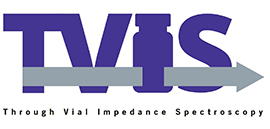Through-vial impedance spectroscopy
Through-vial impedance spectroscopy (TVIS) is a novel process analytical technology for the development of freeze-drying processes and products.
The development of TVIS by De Montfort University, in collaboration with our partners (GEA Lyophil GmbH, Sciospec GmbH, the National Institute for Biological Standards and Control, BlueFrog Design, Sanofi-Ireland, and OncoLytika) marks the first time that impedance spectroscopy has been used to characterize materials within conventional glass freeze-drying vials, without having to insert the electrodes into the product (i.e. the solution under-going freeze-drying).

Benefits
Having the electrodes on the outside of the vial, differentiates our technology from other in-process impedance measurement systems, in which bulky electrodes are inserted into the solution being freeze-dried. The technology is therefore non-invasive to the product and so has zero impact on (i) nucleation temperatures, (ii) the way in which the ice crystals form (growth rates and trajectories), and (iii) drying kinetics.
In addition, the low thermal mass and streamlining of the external electrodes, which are connected to fine ‘flexible’ coaxial cables, means that the technology is also non-perturbing to the packing of the vials in the dryer (thereby maintaining inherent heat transfer characteristics across the dryer).
TVIS enables non-invasive, real time, in-line monitoring of the lyophilisation process, leading to increased process understanding and accelerated product development, especially in relation to the development of room temperature stabilised biopharmaceutical formulations.
Applications
The imaginary part (dielectric loss) spectrum of the test object (the glass vial containing the frozen solution) will typically display one or two peaks within the experimental frequency range (10 Hz to 10 MHz). The peak frequency and the peak magnitude are then used to track the progression of the cycle. The peak frequency is sensitive to the temperature of the ice in the volume space bounded by the external electrodes whereas the peak magnitude is sensitive to the amount of ice remaining within the same region. Calibration of these parameters is achieved by the inclusion of a thermal cycling stage, with a maximum re-cycling temperature not exceeding the glass transition (so as to avoid any changes in ice structure or any damage to the drug substance, especially in the case of biologicals). It is then the calibration coefficients for the re-heating phase of the thermal cycle (rather than the re-cooling phase) which are used to predict the temperature in primary drying and the amount of ice remaining, from which the drying rate may be determined.
In some applications, the use of dual electrode systems (with one pair close to the top, and the other pair close to the bottom of the fill volume) provide a measurement of the spatial distribution of temperature in the vertical direction, from which its possible to extrapolate to the temperatures at both the sublimation interface and the ice-glass interface, at the base of the vial. The base temperature and the drying rate from TVIS are then combined with the shelf temperature, via standard heat and mass transfer equations, to derive estimates for the heat transfer coefficient (on freezing drying of water), whereas the sublimation interface temperature from TVIS is used to determine the partial pressure of the sublimating ice front, which is then combined with the TVIS estimated drying rate and the chamber pressure to determine the dry layer resistance (on freeze-drying of solutions).
Other applications include: (i) the determination and/or prediction of the collapse temperature during primary drying; (ii) The analysis of the low frequency peak associated with the unfrozen (i.e. non-ice) fraction in order to provide information on the structural relaxation in the unfrozen fraction, from which the glass transition may be determined in situ (i.e. within the vial),
For further information contact:
Prof. Geoff Smith
Pharmaceutical Technologies Group
Leicester School of Pharmacy
De Montfort University
Leicester
LE1 9BH
United Kingdom
T: +44 (0)116 250 6298
E: gsmith02@dmu.ac.uk